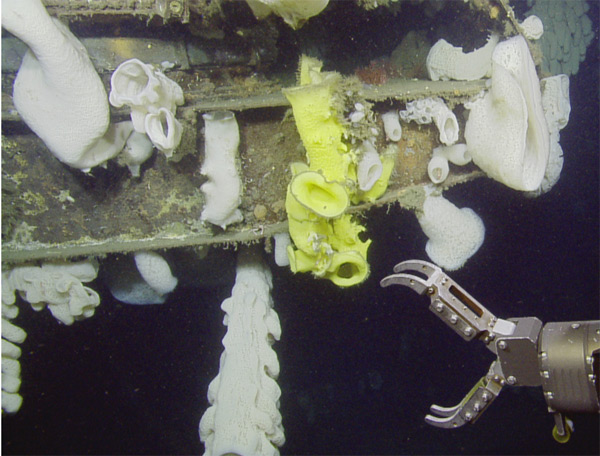Auction to name a new species of sponge

An auction to benefit the Greater Farallones Association has been announced. Here is your chance to have a new species named after you. A previously undescribed species of sponge was found on the USS Independence at a depth of 2,600 feet off the Farallon Islands. The auction runs from April 13th to April 25th and the winner will name the new species of sponge, receive a photographic print of the sponge and a bound copy of the scientific publication where the sponge is described for the first time.
Press Release
Scientists have recently discovered a new species of Picasso sponge, a type of deep sea sponge, (Staurocalpytus sp.) in northern Monterey Bay National Marine Sanctuary waters, and you can be the one to name it! In an effort to support this scientific investigation, the Greater Farallones Association (a San Francisco environmental non-profit that supports the wok of NOAA’s Greater Farallones National Marine Sanctuary) is holding an online auction to name this new species, previously undescribed, from April 13 - April 25. In addition to bragging rights to name this new animal, the winning bidder will receive a print photograph of the new sponge, plus a bound copy of the scientific publication in which the species will be described for the very first time.
Bidding to name this newly discovered sponge begins at $5,000 and is tax deductible. For more information on how you can support the Greater Farallones Association, contact us at donation@farallones.org or join us for the live auction starting April 13.
Where was this deep-sea sponge found? The mystery sponge was found living on the USS Independence, a shipwreck near the Farallon Islands off San Francisco, at a depth of 2,600 feet. After serving as an aircraft carrier in Pacific military operations during WWII, the USS Independence was used as a target vessel for atomic bomb tests in the late 1940s, and was intentionally scuttled offshore in 1951. Since then, many deep-sea marine organisms have made this shipwreck their home.
What is a Picasso sponge? A sponge is a sedentary marine creature with a soft, porous body typically supported by a framework of needle-like fibers, that grows on the ocean floor and other surfaces. A “Picasso” sponge, dubbed for it’s surreal shape, forms barrel-like structures that provide a home for many other marine animals like shrimp, brittle stars, and rockfish.
Picasso sponges are a group of sponges in the Class Hexactinellida, also known as glass sponges. They are called glass sponges because they have glass structures called spicules that are strikingly similar to fiber-optic cable materials. In fact, they are superior to human- made fiber optics, as they are much less likely to break. In addition, sponges can make them at low temperatures, without the intense heat required for human-made optical fibers. Glass sponges give us a biologically inspired process that could give rise to better fiber-optical materials and networks. They also form valuable habitat in which other marine species live.
Interesting fact: You can put a sponge in a blender and it will re-form. Sponge cells are nearly uniform throughout. Because of this, if you put a sponge in a blender, its cells will grow a new sponge and the sponge can live on.